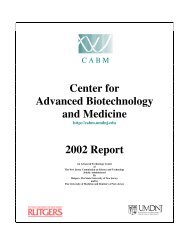Annual Report 2011 - Center for Advanced Biotechnology and ...
Annual Report 2011 - Center for Advanced Biotechnology and ...
Annual Report 2011 - Center for Advanced Biotechnology and ...
You also want an ePaper? Increase the reach of your titles
YUMPU automatically turns print PDFs into web optimized ePapers that Google loves.
Dr. Arnold Rabson<br />
Director<br />
Child Health Institute of New Jersey<br />
Professor<br />
Department of Molecular Genetics,<br />
Microbiology <strong>and</strong> Immunology<br />
Department of Pathology <strong>and</strong><br />
Laboratory Medicine<br />
Department of Pediatrics<br />
UMDNJ-Robert Wood Johnson<br />
Medical School<br />
Dr. Celine Granier<br />
Postdoctoral Fellow<br />
Dr. Hsin-Ching Lin<br />
Research Scientist<br />
Viral Pathogenesis Laboratory<br />
Dr. Rabson’s laboratory studies the molecular basis of cancer <strong>and</strong> human<br />
retroviral infections. His recent research activities are focused in two major<br />
areas: 1) the mechanisms responsible <strong>for</strong> the pathogenesis of retroviral<br />
infections, particularly infection with the human T-cell leukemia virus<br />
(HTLV-1), <strong>and</strong> 2) the roles of cellular transcriptional regulation in<br />
development <strong>and</strong> in human cancer.<br />
It is estimated that over 20 million people are infected by HTLV-1, the first<br />
identified human retrovirus, <strong>and</strong> 2-5% of them are likely to develop a serious<br />
HTLV-1-associated disease. Dr. Rabson is studying the differential mechanisms<br />
by which HTLV-1 causes an aggressive <strong>and</strong> fatal T cell leukemia/lymphoma<br />
(Adult T-Cell Leukemia, ATL) in some infected individuals <strong>and</strong> a series of<br />
immunological disorders including a neurological disease of the spinal cord<br />
(HTLV-associated Myelopathy, HAM/TSP) in other infected people. These<br />
disorders occur in only a minority of patients, years after initial infection. This<br />
suggests that there are important interactions between the virus <strong>and</strong> the host that<br />
determine its pathogenicity. Furthermore, a strong host immune response against<br />
HTLV-1 gene products favors the establishment of latent infection in vivo.<br />
Nonetheless, expression of HTLV-1 gene products, particularly the Tax<br />
transactivator, is required <strong>for</strong> disease development. The Rabson laboratory has<br />
identified <strong>and</strong> characterized the mechanisms by which the expression of HTLV-1<br />
can be activated in infected human T-lymphocytes leading ultimately to disease<br />
pathogenesis. They have shown that stimulation through the T-cell receptor can<br />
potently induce HTLV-1 gene expression, including the expression of Tax,<br />
leading to T cell immortalization. They have recently confirmed this in a mouse<br />
model of HTLV-1 latency <strong>and</strong> gene expression. T cell receptor stimulation of<br />
CD4+ cells in a Tax transgenic mouse leads to increased T cell proliferation <strong>and</strong><br />
long-lived survival (>13 months). Thus, activation of latently infected T cells in<br />
HTLV-1-infected individuals may induce expression of Tax, ultimately leading to<br />
proliferation of subsets of cells, based on specific T cell receptor-lig<strong>and</strong><br />
interactions. This could explain the progressive polyclonal to oligoclonal<br />
proliferation to ultimately monoclonal proliferation of infected T-cells that<br />
characterizes HTLV-1-associated diseases.<br />
29



